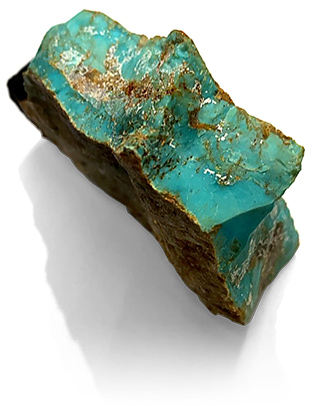Turquoise
A mysterious blue jewel, turquoise that has been worshiped since ancient times
Turquoise has been used as a jewel that possesses mysterious power in ancient Egypt and in the myths of the Indians. The mysterious blue jewel was a stone with a unique magical power that attracted people from ancient times.
What kind of gem is turquoise
Respected for its ancient civilization, the Indians called it the stone of God
Turquoise, also called turquoise, is said to be the oldest gem in the world. From ancient Egyptian royal tombs around 3000 BC, burial red with gold turquoise was found, and turquoise was also used for the burial of King Tutankhamen. Turquoise beads have also been excavated in Mesopotamia. Turquoise has been loved by people as a jewel since the times of ancient civilization.
Among them, it was American Indians who discovered the mysterious power of turquoise. Turquoise has also been found in the ancient ruins of the Anasazi tribe, their ancestors. In Navajo mythology, turquoise is the stone of God with holy power.
Discovering beautiful blue stones in the desolate deserts of the Southwestern United States, they thought it was a special gift from God, either a piece of the sky or a chunk of water.
Whether it was a ceremony for praying for successful hunting or good harvest, or a ceremony for rain begging, turquoise was always dedicated to God.
Wearing turquoise, a stone that holds the power of God, protects you from evil and brings good luck. In addition, passing on this stone to a child gives the child the power of the stone. In this way, they have passed down turquoise from parent to child for generations.
Birth and development of Indian jewelry
It is said that the Indian jewelery that combined ancestor turquoise with silver was born around 1880. Indians who learned silverwork had begun to make accessories and daily necessities, but one theory is that one of those silversmiths, a Navajo slender maker, put turquoise on silver jewelry.
Since then, the first phase, which was in its infancy, and the second phase, when it was widely sold to white traders, jewelry makers steadily improved their skills, and many genius artists appeared and sublimated into art. During the contemporary era, Indian jewelery using turquoise has become highly regarded around the world.
The lucky stone, turquoise, is now worn by people around the world as jewelry.
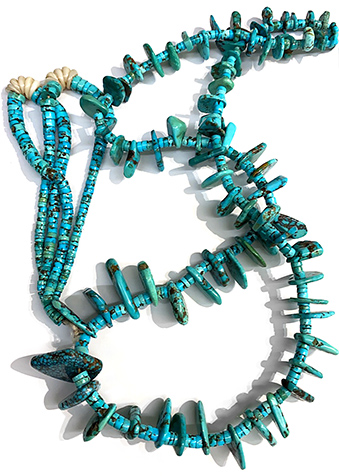
Hishi necklace and earrings
The beaded turquoise necklace and earrings were dressed in Indian style.
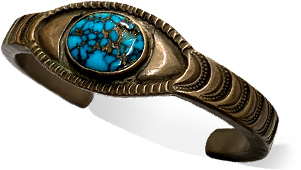
Ingot bracelet
An ingot is a work of the 1930s made by melting silver coins. Old Burnham turquoise is set.
How to distinguish turquoise
What is "natural"?
Turquoise is not very hard as a gem and its surface is porous with numerous holes. For this reason, most of the stones that are not sufficiently hard to make as they are or that are easily discolored due to the entry of sebum from the surface holes, etc.Most of the stones on the market are filled with resin to increase their hardness. It has been processed such as.
Natural refers to as-produced stone that has not been processed. Only high-quality stones with few holes on the surface and high hardness are rare because they are natural and can be made into jewelry. It is said to be only a few percent of the whole, and is very valuable.
What's more, the number of well-known mines in the southwestern United States is very low. Many of these classic mines have been closed, and it is said that few high-quality stones from the famous mines will be released in the next few decades, and they are also investment targets.
In general, it is said that it is difficult to distinguish whether it is natural or not because of various processing processes (described later).
Our store sells jewelry centered around natural products from typical American mines, but if you go to most of those mines and grasp the environment and soil quality, you can see the turquoise color produced by each mine. Judgment is made based on the consistency of variations and patterns.
Thanks to this knowledge, I have been recognized as a stone knowledge and appraisal even in the United States, and I also served as a judge at the Santa Fe Indian Market, which boasts a tradition of about 100 years. Still, there are some difficult parts, and if there is little information on the stone, we carefully check it by keeping it for a long time and observing changes over time.
Whether it's natural or not is hard to judge, and if you get it, you can buy it from a reliable source.
Points to identify good turquoise
The value of turquoise as a gem depends on various factors such as color and hardness, when and in which mine it was mined, its shape when it was mined, and the inclusion of impurities called matrix.
A good stone condition is that the matrix is well colored and dark, and the matrix where the host rocks enter the turquoise as lines to form a pattern is thin.
Darker color means that copper is a strong turquoise, dense and hard stone. On the contrary, if the color is light, there is little copper and many holes on the surface, making it a soft stone. Sebum etc. enters the hole, and bright blue tends to change color to green.
It is well known how to enter the matrix is a spider web with fine lines in a mesh shape. Turquoise is harder for smaller particles, and a spider web is formed when it is lumped together by the host rock. These stones are very hard, and even if they are used as jewelry for a long time, they hardly scratch or discolor. If the matrix does not enter, it becomes a soft stone.
Turquoise rough
The stone produced by the widow maker is on the left, and the blue diamond stone is on the right. The black part is the chart. It is natural that the raw stone is carved out.
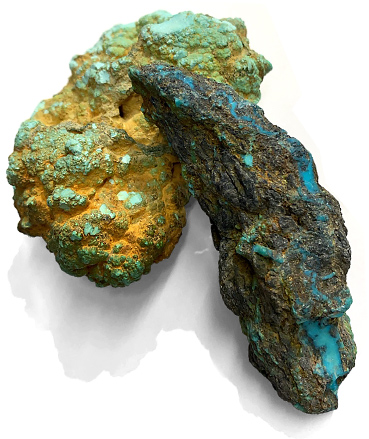
Different matrices in the mine
Lone Mountain, Candelaria, Number Eight, Lander Blue Stone. Each has its own character, but it is said that a matrix that is fine and even and has thin lines is good.
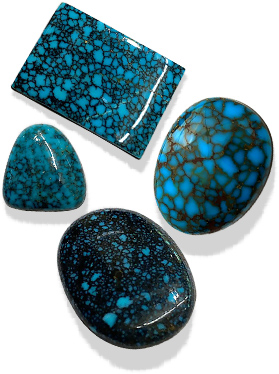
American mines and their characteristics
Features that vary by mine
Since the environment varies depending on the mine, the turquoise produced is characteristic. In the southwestern United States, Nevada is said to be the sacred site for turquoise, but the three major mines are considered to be exceptional among the turquoise producing areas.
The mines are Number Eight, Lone Mountain, Randable. Producing stones of high quality and beautiful colors and patterns has made it popular worldwide and its price is high.
Randable in rarity and number eight in high hardness, but Lone Mountain has the tenacity that is most suitable for jewelry.
The characteristics of turquoise produced from the three major mines and other representative mines are as follows.
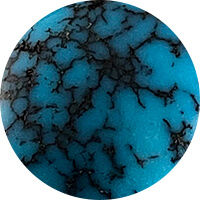
Lone Mountain(ローンマウンテン)
Lone Mountain is one of the three major turquoises loved by master artists such as Charles Loroma. Although it reached its peak in the 1970s, the ore deposit was destroyed due to dangerous mining activities, and mining is now being carried out in detail according to a detailed mining plan.
In addition to its rarity due to the small amount of mining, the stone is very popular due to its vivid deep blue color, hardness with almost no discoloration or discoloration, and the luster that results from it. There are many fans with a unique appearance in which the matrix of black, brown, and gold brown runs to a blue that turned a little green, and the stone of the highest grade is known as "Golden Web".
The turquoise that Kodera loves most.
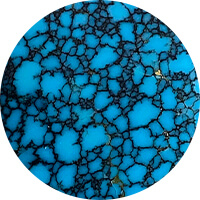
Number Eight(ナンバーエイト)
The most popular number eight among turquoise freaks. Counted as one of the three major turquoises, the mine was once a major production area boasting a mining amount of about 3,000 km in five years after the start of mining. However, it can no longer be mined because it was destroyed in 1976 due to the transfer of rights.
The contrast of the black to brown matrix stretched sharply over the clear, vivid light blue, which is close to that of a clear sky, is very beautiful. The highest grade is a stone in which a black cobweb-shaped matrix is evenly filled.
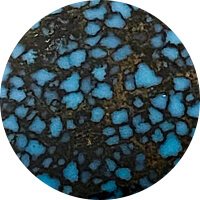
Lander Blue(ランダブルー)
Randable is a relatively new mine. Nevertheless, it is the individuality of the stone that boasts the popularity of being one of the three major turquoises.
Massive mining randables have a very unusual feature in that almost every stone has a black spider web. The contrast between deep blue and jet black is beautiful, and when it comes to the highest grade, the whole looks violet. Randables, which are rare and have a total mining amount of only about 40km, are traded at a particularly high price among turquoises.
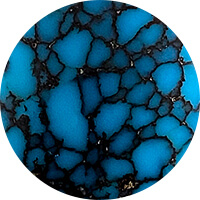
Godber/Burnham(ガドバー/バーナム)
The ore deposit was found in the highlands of 2100 meters above sea level in 1932 and is still being mined even on a small scale. Light blue to dark blue stones may contain a red matrix and may be mixed with crystals.
Most of the stones are lumpy, and since a large amount of aluminum is contained in the component, it has a whiteness and a milky blue stone with a transparent feeling. For high grade and above, there is a wide range of stones that can be mined, as a strong matrix of tea is contained in it, or a remarkable blue stone is mined.
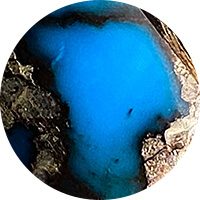
Bisbee(ビズビー)
Even in Arizona, where many turquoises are mined, Bizby has an outstanding presence and popularity.
It is characterized by a unique matrix that appears as if a purple fog was cast on the blue sky, because red particles are mixed in a vivid deep blue stone. The stone with reddish-black, soot-like spots and streaks all over the surface is called "smoky visby" and is very popular. The color of the stone is wide, ranging from transparent light blue to dark blue, with some greenish colors. As the grade increases, the luster and depth of blue increase, and the hardness is also characteristic.
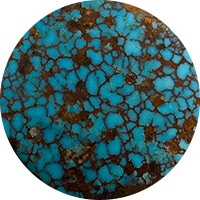
Nevada Blue(ネバダブルー)
Also known as Timberline, Indian Mountain. It is located at a high altitude in the Landers County, Nevada, and was discovered in 1970 by the Shosheau shepherds. Collected in lumps, beautiful light blue stones sometimes contain round crystal grains with beautiful black, brown, and yellow-brown matrix colors. Charles Loroma has also been a favorite of jewelry.
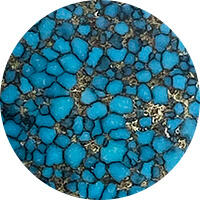
Indian Mountain(インディアンマウンテン)
With increasing grades, the turquoise's own blue became clear and transparent, and the black matrix was evenly distributed.From around 1970, mining began in the Landers, in the central eastern part of Nevada. It is said that a Shoshone Shepherd was discovered by accidentally tripping a vein while grazing a sheep.
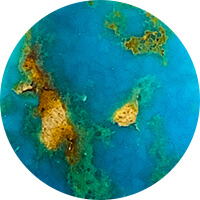
Blue Gem(ブルージェム)
Located in Lander County, Nevada, it boasted one of the highest mining volumes in the state at its peak. Most of the blue gem deposits were vein-like, with some stones hard enough to be about 2 cm thick. As its name suggests, the transparent blue color is attractive, and when it comes to top-grade products, the vivid blue color is characteristic. Also known as "Royal Blue", it is still popular today. It is also famous for its wide range of color variations from green to blue throughout the vein.
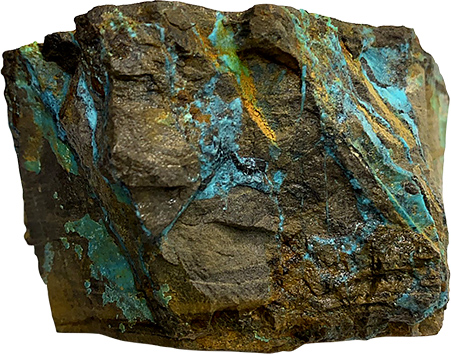
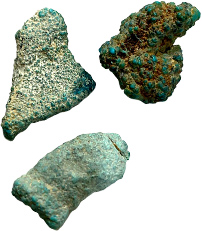
Veins and lumpy gemstones
The veins are on the top. Below is a massive stone. The chunks are called "nuggets".
Shape when mined is also important
In turquoise mining, we first look for vein-shaped turquoise that appears thinly on the rock surface. The veins are formed so as to fill the crevices of the host rock, are light in color and weak in hardness, and are easily cracked. However, as you dig in, the thickness may increase a little.
More valuable is the one that is mined in blocks called nuggets. Turquoise particles grow little by little under pressure in the host rock, increasing the hardness. Fine stones were mined in the shape of nuggets at the three major mines.
What is Imitation Stone?
The vein-shaped turquoise generated in the gap between stones is not compressed as the gap is wider, and if the thickness is 5 mm or more, the hardness is weak and the color is not beautiful.
Such stones, and stones with a lower density called chalk, are subjected to processing such as injecting and coloring resin or plastic.
Although there are several processing methods, the most commonly used method is "Stabilized", which is a method of increasing the hardness by injecting resin at high pressure into holes in the surface. If the color is light, there is a method called “Dyed Stabilized” in which a blue dye is added and injected. For very small stones, a method called "reconstituted" is used in which they are powdered once and then combined with resin or paint. There is also an "enhanced" process that uses chemicals and electricity. In addition, there are also processing methods such as "Dyed", which colors blue and darkens the matrix, and "Waxed," which has been used since ancient times to apply wax or oil.
When you get turquoise, you need to be careful that most of them are processed. Again, there are few ways to avoid this other than getting it in a reliable location.
t SKYSTONE TRADING, we use our years of experience and connections with local miners, jewelery writers, and collectors to showcase highly reliable and rare turquoise jewelry and the works of famous writers to Japanese people. Introducing. We have turquoise jewelery of the quality only here in the world, so if you are interested in turquoise or are interested but do not know in detail, please contact us once.
Kingman Stabilized
Stabilized is used not only to increase hardness, but also to darken stone color.
